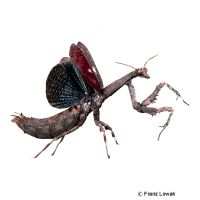African Twig Mantis (Popa spurca)
| African Twig Mantis Popa spurca | |
|---|---|
| Name | African Twig Mantis |
| Name Lat. | Popa spurca |
| Family | Deroplatyid Mantises |
| Family lat. | Deroplatyidae |
| Order | Praying Mantids |
| Order lat. | Mantodea |
| Origin | Africa |
| Habitat | Savanna |
| Diet | Flying insects |
| Humidity | 40-60 % |
| Behavior | Predatory |
| Keeping | Individual |
| Care Level | Moderate |
| Housing | Dry terrarium |
| Breeding | Moderately difficult |
| Life Span | 2-6 months |
| Protection | No |
| Metric Units | |
| Size | 7-8 cm |
| Temperature Day | 28-35 °C |
| Temperature Night | 20-22 °C |
| Housing Size | 20 x 20 x 30 cm |
| US Units | |
| Size | 2.8"-3.1" |
| Temperature Day | 82-95 °F |
| Temperature Night | 68-72 °F |
| Housing Size | 10" x 10" x 10" |
Distribution and habitat
The distribution range of the diurnal Lesser Astmantis extends over large parts of Africa south of the Sahara and Madagascar. They inhabit the dry savannas, where they live well camouflaged on bushes and shrubs.
Maintenance
For a female an insectarium of at least 20 x 20 x 30 cm (L x W x H), for a group of up to 5 males 30 x 30 x 50 cm, can be recommended as a guideline, which should be placed in a quiet place without sunlight. A cover of gauze or fine metal mesh is recommended.
You will need an insectarium structured with finger-thick climbing branches (hiding places, privacy screens) with a cork back wall, drought-resistant or artificial plants, a substrate of sand-soil mixture (terrarium humus) and pieces of bark, and a small, shallow drinking vessel with water gel or a cotton trough. The interior of the terrarium should be lightly sprayed with water every 2-3 days, preferably in the evening, but a rain or mist system is better. Too much humidity is not tolerated and good ventilation should be provided.
| Temp. day: 28-35 °C | Temp. night: 20-22 °C | Humidity: 40-60 |
The lighting duration should be 12 hrs. Light sources that also produce the necessary heat are ideal.
Diet
They are predatory and often lurk motionless for hours with their tentacles stretched far forward in search of prey, preferably insects, which they seize with lightning speed. The food supply should consist of crickets, house crickets, flies (Drosophila) and grasshoppers as well as small arachnids. It is important to regularly add minerals and vitamins (e.g. by dusting the feeders). The quality of the feeders can be enhanced by feeding overripe fruit and honey water. A few days before, during and after molting, they refuse to eat. During molting, no predatory feeders (e.g. crickets) should remain in the insectarium, as during this time the animals are unprotected and may become prey themselves.
A varied diet promotes health and prevents deficiency symptoms.
Reproduction and breeding
Adult females tend to be larger and more powerfully built than the slimmer males, which have slightly longer wings.
After mating, which lasts several hours, the female lays up to 8 flat egg packages (oothecae), about 2 cm in size, mostly on the ground after 1-5 days at intervals of 3-4 weeks. After about 4-5 weeks, about 100 larvae hatch from each egg packet. They should be fed immediately with small fruit flies or micro echinoderms so that they do not eat each other (cannibalism).
After imaginal molting, males are ready to mate after about 10 days, females after about 14 days. After that the males live about 2 months, the females about 6 months.
Important
It is recommended to keep females singly. The Lesser Astmantis have a very mobile, triangular head with large, laterally arranged eyes and are very similar to a branch (branch mimesis).
To molt, they hang upside down in branches or on the lattice cover and slide out of their old shell. Therefore, they need at least one body length of free space below them.
Before purchasing, an insectarium should be prepared that meets the species-specific needs. Good ventilation without drafts is necessary, as well as equipment for measuring temperature and humidity. The lighting must correspond to the day-night rhythm appropriate for the species and must be installed in such a way that the animals cannot injure themselves. The insectarium should be locked in such a way that neither unauthorized persons can open it nor the animals can escape. Special attention must be paid to thorough hygiene and contamination must be removed regularly.
Further literature can be found in your pet store.
References
Text: petdata; Image: Franz Lowak
Source: HENKEL & SCHMIDT (2010): Taschenatlas Wirbellose für das Terrarium, Verlag Ulmer; ENGELMAN & LANGE (2011): Zootierhaltung - Tiere in menschlicher Obhut: Wirbellose, Verlag Harri Deutsch
